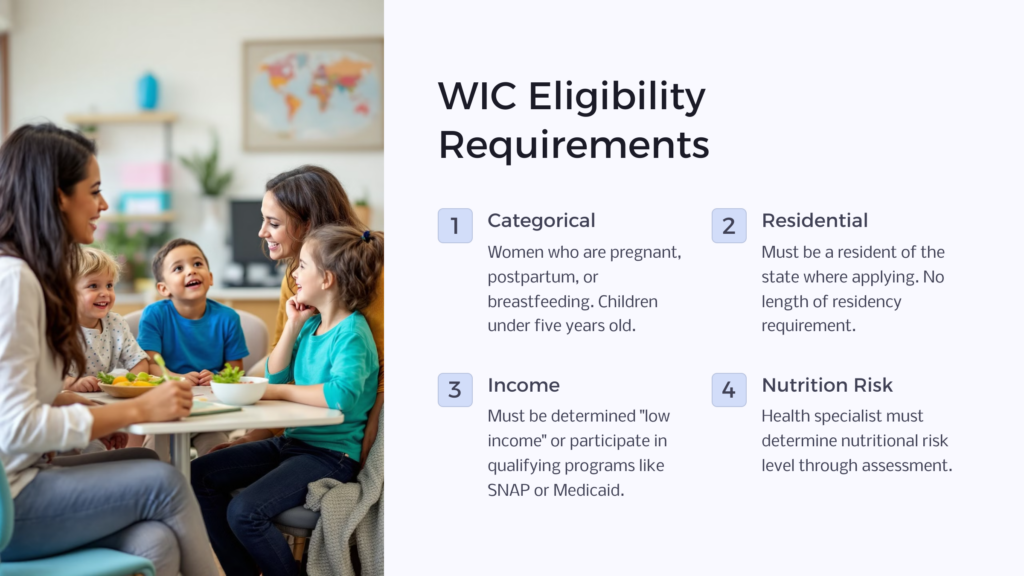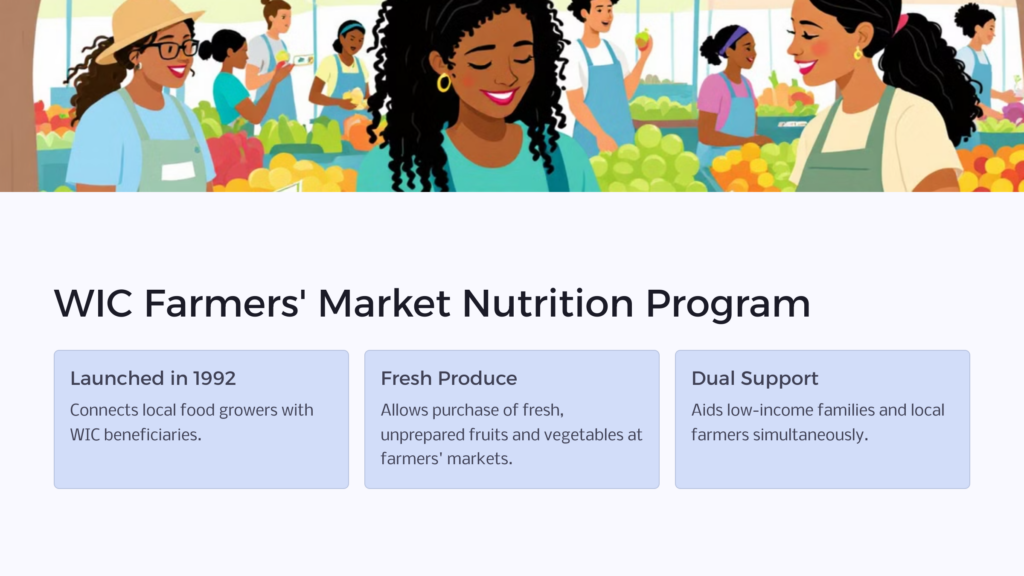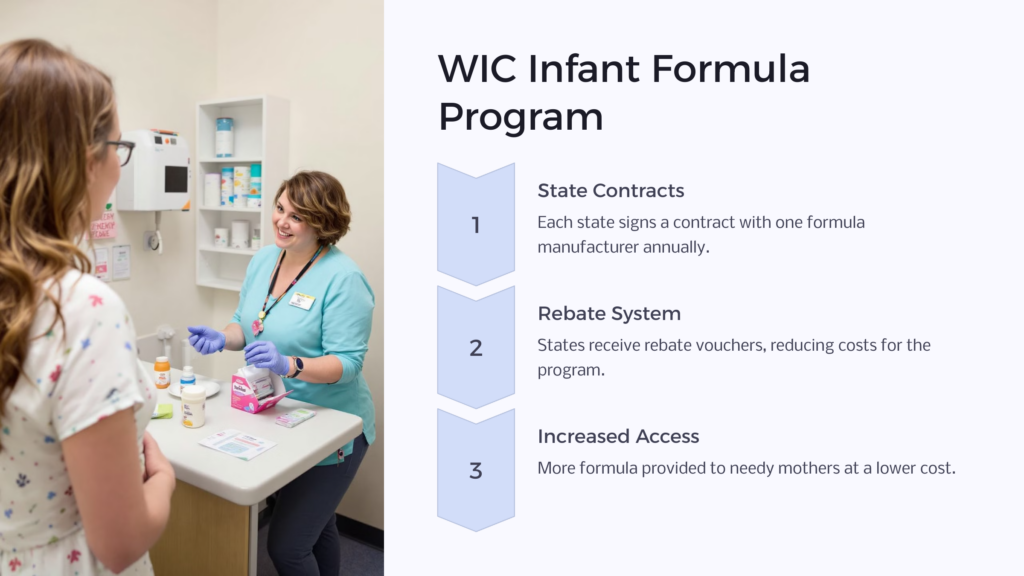The Special Supplemental Nutrition Program for Women, Infants, and Children, more commonly known as the WIC program, is a federal program serving women and young children who are deemed to be at nutritional risk.
Recipients must meet certain requirements to be eligible for the program. WIC benefits include access to buy or receive nutritious food, nutrition education specific to pregnancy and breastfeeding, and other social services such as health care.
4 Requirements To Qualify For WIC Benefits
- Categorical: With certain exceptions, you must be a woman or child under the age of five
- Residential: Although a federal program, most WIC recipients receive aid through a local agency
- Income: Participants must be determined to be “low income”
- Nutrition Risk: All beneficiaries must meet with a health specialist to ascertain the level of their nutritional risk

On the national level, the WIC program is run by the U.S. Department of Agriculture’s (USDA) Food and Nutrition Service (FNS). On the state level, the WIC program is administered by local and tribal organizations. This joint federal and state program has been helping Americans most in need of nutritious food since 1972. Those looking to receive WIC benefits should contact their local agency or check eligibility criteria through the WIC prescreening tool.
What Is the WIC Program?
The WIC program was started in 1972 as a pilot program in Kentucky to help low-income pregnant women, new mothers, and young children improve their nutritional health and fight malnutrition. Two years later, the program expanded into 45 states.
Today, WIC is administered by both at the federal and state level in all 50 states, 33 Indian Tribal Organizations (ITOs), and in the U.S. territories of Guam, Puerto Rico, American Samoa, the Virgin Islands, and the Northern Mariana Islands. There is also a WIC Overseas program serving civilian employees, those working for the Department of Defense, and family of service members.
WIC is committed to reviewing and revising legislation and guidelines based on up-to-date findings both from a nutritional perspective, and data on the needs of low-income Americans.
Throughout its lifespan, WIC has expanded to include comprehensive nutritional education to supplement the healthy food provided to recipients. It has a major focus on educating and increasing the prevalence of breastfeeding. Past WIC recipients volunteer for the role of peer counselor or a trainer for new mothers who may be hesitant to begin breastfeeding.
Although breastfeeding is considered the optimal method for feeding a newborn, they recognize this is not an option for all mothers, either by choice, cultural factors, or medical needs. An infant formula program has been developed for those families who need it. WIC continues to respond to updated nutritional guidelines set by the USDA.

WIC beneficiaries will typically receive an EBT card (electronic benefit transfer) that can be used at participating grocers to buy WIC foods. There may be some local programs that still issue paper coupons, but the majority of WIC clinics have switched over to EBT cards due to a mandate to use electronic cards entirely by October 1, 2020.
Understandably, the COVID-19 pandemic has delayed some of this implementation. These EBT cards can help buy program-approved food items such as fruits and vegetables, milk, whole grain cereals and breads, eggs, cheese, premade baby foods, and iron-fortified infant formula. Some states may have WIC-only stores where the cards can be used.
How WIC Helps
The WIC program has been helping low-income women and children with supplemental food and nutritional information to promote healthy eating and wellness since the early 1970s. It is widely believed to be one of the most successful and cost-effective nutrition-based federal programs.
Sometimes, the program will deliver an individual food package to a WIC family. However, most beneficiaries are supplied with EBT cards to purchase foods from participating grocery stores or farmers’ markets, much like a food stamp program.
The program can also provide aid for other health concerns either through the local WIC clinics, or referrals to partnering clinics in the area. These services can include health screenings, breastfeeding information and support, immunization screening, and substance abuse referrals.
Through this approach, WIC recipients experience fewer premature births, fewer low-birth-weight babies, fewer fetal and newborn deaths, an increase in pre and postnatal care, an increase in healthy foods and overall dietary health, an increase in the number of breastfeeding mothers, and access to more health care services.
WIC also sees positive outcomes for the children who receive benefits. Those who were in the WIC program when they were young are more likely to have regular health care throughout their lives, improved growth rates, decreased likelihood of iron deficiency anemia, increased immunization rates, improved intellectual abilities as seen in academic growth and vocabulary, and an overall improvement in their diets.
4 Requirements To Qualify For WIC Benefits
There are four basic requirements that all recipients must meet to start receiving WIC services. Those who are curious about their WIC eligibility can use the WIC prescreening tool as a good starting point. This online platform allows potential applicants to enter basic personal information about themselves, their families, their income, and their overall lifestyle to test their likelihood of qualifying.
The tool also provides contact information for the closest WIC clinic and you can schedule a WIC appointment to verify your information and ask further questions about services.
1. Categorical
To qualify for benefits, a WIC participant must be a woman or child. You must either be a pregnant woman, postpartum (up to six months if not breastfeeding), or actively breastfeeding up to a year after the baby is born. Infants and children can qualify for benefits up to their fifth birthday. Foster parent WIC families can also qualify if they have children under the age of five.
2. Residential
You must be a resident of the state where you are applying for WIC benefits, though there is no length of residency requirement. Some state agencies may require individuals to apply for the program through the local WIC clinic where they live.
If you are a current WIC recipient and plan on moving, you should notify your local office so they can help with the transfer. When you get to your new state, you will need to contact the local WIC office and they will put you on the top of their waiting list to receive services.
You may also continue to receive some benefits from your original state if your local clinic gives you a special card you can present to the new clinic verifying your participation in the program. You will not need to re-qualify as long as your initial certification has not expired and you can prove you have been receiving services.
3. Income
Each state can set its own WIC income guidelines, but they must be within 100% and 185% of the federal poverty level, set each year by the Department of Health and Human Services (DHHS). For example, at 185% of the federal poverty level, the annual income limit for a family of three is $40,182, with a monthly income limit of $3,349.
You can bypass these income requirements if you are currently part of an existing program that has already screened for income eligibility like food assistance programs, Medicaid, SNAP benefits (Supplemental Nutrition Assistance Program), Temporary Assistance for Needy Families (TANF), or a state-administered program.
4. Nutrition Risk
Each applicant must be seen by a healthcare professional such as a doctor or nurse, and determined to be at “nutritional risk.” This process is often done at the clinic by a WIC nutritionist if the applicant does not have a primary care physician who’s already evaluated them. The applicant must have, at minimum, their height and weight measured and have a blood test. The clinician will also ask the applicant questions about their normal eating habits and access to healthy foods.
There are two types of conditions deemed to be a nutrition risk:
Medically-based – being anemic, underweight, an advanced maternal age, or a history of poor pregnancy outcomes
Dietary-based – inadequate access to a healthy diet, or a history of choosing unhealthy foods
A medically-based condition is considered a higher priority than a dietary-based condition.
WIC Farmers’ Market Nutrition Program

Launched in 1992, the Farmers’ Market Nutrition Program (FMNP) connects local food growers with WIC beneficiaries and lets them use part of their spending allowance on fresh, unprepared fruits and vegetables sold at local farmers’ markets. This program aims to support two groups of Americans: low-income women and children who need better access to healthy foods, and local farmers and food producers who may need extra assistance with sales.

WIC issues their recipients coupons that can be used at farm stands, roadside stands, directly from farmers, and farmers’ markets with an approved WIC vendor. Since farmers’ markets are by their nature regional, FMNP is currently administered at the state level or with Indian Tribal Organizations and is currently in 49 states. Participating local agencies must submit a state plan each year to the FNS office to receive funding.
The federal government covers 100% of the food costs and 70% of the administrative costs for this program with the remaining 30% being supplied or fundraised by local offices. Approximately 1.2 million people have received food through the FMNP and it has become so popular that a similar program for seniors, the Seniors Farmers’ Market Nutrition Program (SFMNP), has been established to further support needy Americans and farmers.
WIC Infant Formula Rebate System

Although the WIC program and its local clinics encourage mothers to breastfeed their infants, they recognize this is not attainable for everyone and instead provide iron-fortified infant formula for mothers who choose to feed with this method.
To reduce costs to the program and provide more formula for the roughly 21% of WIC beneficiaries who are new mothers, each state program is allowed to sign a contract with one formula manufacturer for the year and in exchange gets rebate vouchers for their participants. This mutually beneficial process allows WIC to provide more formula to needy mothers at a lower cost.
WIC supplies an infant formula calculator to help new mothers determine how much formula they’ll need to feed their child. This also helps local agencies know how much formula to distribute to each recipient based on the needs of their child. Importantly, you’ll need to know the brand of formula, how it’s packaged (liquid or powder), the size of the container, and how often you receive your food packages to get an accurate estimate.
Healthy Benefits of the WIC Program
For nearly 50 years the WIC agency has been connecting needy women and children with much-needed access to nutritious foods, education about nutrition for mothers and young children, and supplying references for additional social services as needed.
Over 6 million Americans are currently receiving WIC benefits. This includes nearly half of all infants born in the U.S. The program continues to adapt to the changing needs of Americans and has shown this specifically during the recent Covid 19 pandemic.
The WIC program has adapted to the health crisis by increasing remote servicing options, broadening the types of foods that beneficiaries can purchase due to food shortages early on in the pandemic, and increasing the number of food packages as women and children across the country struggle to stay afloat with limited employment and childcare opportunities.
If you’re a newly postpartum woman, currently pregnant, or a mother to young children under the age of five, consider contacting your local WIC office or using the online prescreening tool to see if you qualify for coverage. Local offices can connect you with a WIC staff member who can help you navigate your options, answer questions about program information, and help you apply for services.
 Benefits.com Advisors
Benefits.com Advisors
With expertise spanning local, state, and federal benefit programs, our team is dedicated to guiding individuals towards the perfect program tailored to their unique circumstances.
Rise to the top with Peak Benefits!
Join our Peak Benefits Newsletter for the latest news, resources, and offers on all things government benefits.




















